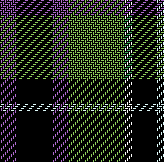 The History of the Kilt.
The History of the Kilt.The Gaelic word for tartan, Breacan, means partially colored or speckled, and every tartan today features a multicolored arrangement of stripes and checks. This pattern, known as a sett, identifies the clan, family, or regiment of the highlander. Not only is the tartan used for kilts but it is also used for trews (trousers), shawls, and skirts.
The first tartans, originally a weaver’s own designs, were eventually adopted to identify individual districts and finally clans and families. The first recognizable effort to enforce uniformity throughout an entire clan was in 1618, when Sir Robert Gordon of Gordonstoun, wrote to Murry of Pulrossie requesting that he bring the plaids worn by his men into “harmony with that of his other septs.”
After 1688 and the fall of the Stuart clan and subsequent rise in the spread of Jacobism, the English government felt it needed to take a more active interest in Highland affairs and enacted the Act of Union in 1707. It temporarily succeeded in uniting the political factions and clans but soon made the tartan a symbol of active nationalism and was seen by the ruling classes to be a garb of extremism. This act of parliament also succeeded in uniting the High and Lowlanders, by spreading the custom of wearing the kilt to the Lowlands, which were not known for doing so.
The Belted Plaid.
During the seventeen hundreds, the breacan feile was slowly being replaced by the military, belted, or pleated kilt. This new kilt design became popular and had the pleats and straps permanently sewn in place. The plaid, or the part that is often worn over the shoulder, became a separate piece that could be removed when it became inconvenient.
After the rising of 1715, the English Government found it necessary to enforce tighter control over the Scottish. A number of independent companies were formed to curtail the lawlessness that had developed. One of these groups consisted of a large number of highlanders that enlisted to serve in the private ranks of the English Army. Many an English officer was surprised to see these Scottish privates attended by personal servants who carried their food, clothing, and weapons. This independent regiment became known as the Black Watch due to the darkly colored tartans they wore. The Black Watch Tartan was the first documented tartan to have an official name and possess the authenticity of a full pedigree.
In 1746, the Government enacted a law making it illegal for Highlanders to own or possess arms. A year later, ‘The Dress Act’ restricted the wearing of Highland dress in any form including the breacan feile. Punishment for a first offense was a six-month imprisonment with a second offense buying a seven-year exile to an overseas work farm. Even the Bagpipes were outlawed, being considered an instrument of war. Only those individuals in the army were permitted to wear colors and as a result, many Highlanders enlisted simply to wear their comfortable traditional dress.
By the time the Dress Act was repealed in 1783, the traditions of the highlanders had been forever changed. The Dress Act succeeded in altering highland society to the extent that many of the old traditions and customs had been lost forever. In spite of the many efforts, wearing of the kilt and colors was seen only as a nationalistic statement, no longer considered a way of life for Highlanders.